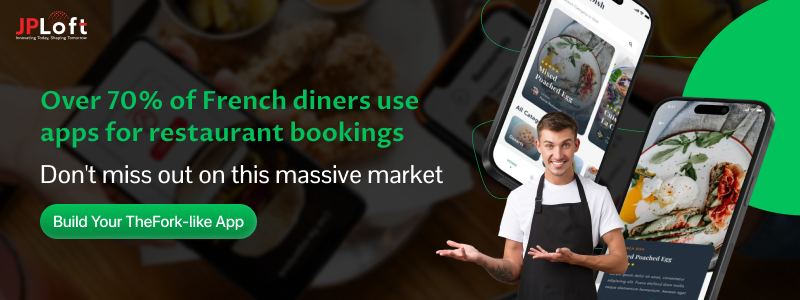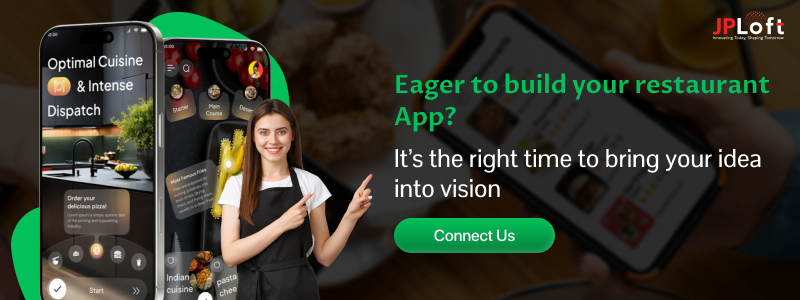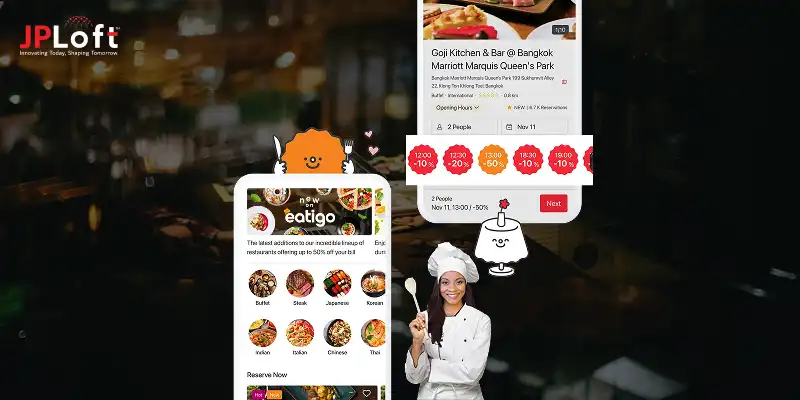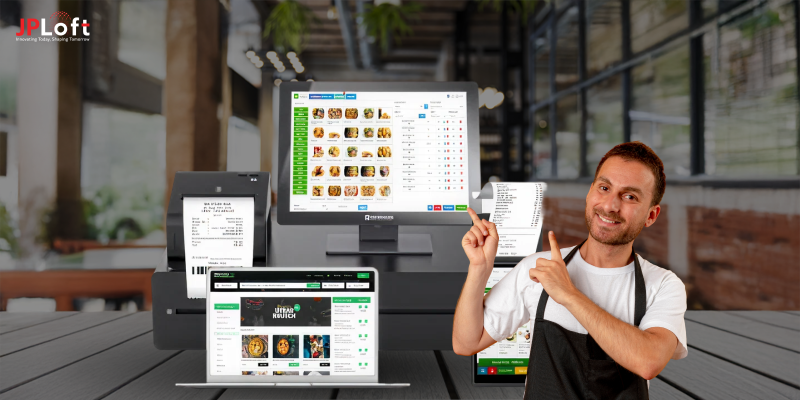Want to Build a Restaurant Booking App Like TheFork? Start Here
TheFork has transformed the way diners used to reserve tables in France just by offering convenience, real-time availability, and exclusive deals.
Today, digital-first dining is the first preference for both users and restaurant owners. That's why apps like TheFork have become essential tools in this digital era.
Therefore, if you’re looking to be a part of this growing opportunity, building a restaurant reservation app like TheFork could be your next big move.
Here, in this blog, we’ll walk you through everything you need to know. From must-have features and AI integration to development cost, monetization, and more, so you can confidently plan and launch your own successful dining app in France.
Key Takeaways:
TheFork’s success in France proves that digital dining apps are now a mainstream preference among users and restaurants.
Building a restaurant reservation app like TheFork requires real-time features, seamless UX, and localized innovation.
Monetization models like commissions, premium listings, and loyalty programs can drive recurring revenue.
AI plays a vital role in user retention, smart search, no-show prevention, and operational efficiency.
Development costs can range from €18,000 to €90,000+, depending on features, platforms, and team structure.
With the right strategy and development partner, you can confidently launch a scalable TheFork-like platform in France.
What Is TheFork? A Look at France’s Leading Restaurant Booking App
TheFork is one of Europe's most recognized restaurant reservation platforms, and in France, it’s the undisputed leader.
TheFork was launched in 2007 and was later acquired by TripAdvisor for $140 million in 2014.
The restaurant booking app enables users to search, compare, and book tables at over 60,000 partner restaurants across 11 countries. France is its largest and most active market.
Quick Stats: TheFork at a Glance
|
Metric |
Data |
|
Founded |
2007 |
|
Acquisition |
TripAdvisor, $140M (2014) |
|
Partner Restaurants |
60,000+ |
|
Monthly Users |
20M+ (web + app) |
|
App Downloads |
10M+ |
|
App Ratings |
★4.8 (iOS), ★4.6 (Android) |
|
Market Share in France |
70%+ |
The app offers real-time availability, dynamic discounts, loyalty points, and seamless payment integration.
On the app stores, it holds a stellar reputation with 4.8★ on the App Store, 4.6★ on Google Play, and over 10 million downloads globally.
Restaurants benefit from TheFork’s CRM, table management, and promotional tools, while users enjoy fast bookings, verified reviews, and exclusive offers.
It’s no surprise that TheFork ranks among the best restaurant apps in Europe.
TheFork’s dominance in France shows how digital-first dining has become the norm.
If you’re looking to create a restaurant reservation app like TheFork, this platform sets a high benchmark and a clear opportunity.
Why Should You Create an App Like TheFork?
Before you evaluate “how to make an app like TheFork?” you need to learn about “why”.
Building a restaurant booking app like TheFork isn’t just trendy, it’s a smart, scalable business move aligned with changing user habits and market needs.
Here’s why it makes sense today:
1] Exploding Market Demand
The global online food service industry is projected to exceed $500 billion by 2027, and restaurant reservations are a growing subset.
In France, more than 60% of urban diners now prefer to book tables online or via mobile apps instead of calling.
2] Recurring User Engagement
Dining out isn’t a one-time action; it’s part of people’s routines. This is another important reason to develop an app like TheFork.
That makes these apps ideal for high retention, recurring traffic, and behavior-driven marketing through personalized offers, loyalty programs, and push notifications.
3] Multiple Revenue Opportunities
Like TheFork, your platform can generate income from multiple sources.
Including restaurant listing fees, commissions on reservations, promoted listings, in-app ads, or even premium user subscriptions for exclusive dining perks.
4] Restaurants Need Digital Booking Tools
From small bistros to high-end eateries, restaurants rely on apps to increase visibility, reduce no-shows, and optimize seating during off-peak hours. Hence, it is important to build an app like TheFork.
A well-built platform adds real value to their operations and solves common issues that often lead to failure, as discussed in Why Restaurant Apps Fail.
5] Validated, High-ROI Model
TripAdvisor’s $140 million acquisition of TheFork shows how valuable this business model is when executed well.
Entrepreneurs who create a restaurant reservation app like TheFork can scale across markets and even expand vertically (e.g., events or chef experiences).
6] Innovation Opportunities Await
The market isn’t saturated; there’s room to innovate with AI-powered recommendations, local language support, dietary-based filters, or social sharing features for group bookings.
If you’re exploring how to start an online restaurant business, launching a reservation app can be your most profitable entry point.
All signs point to now being the right time to make a restaurant reservation app like TheFork, especially for those who want to blend tech with tangible business results.
Must-Have Features to Develop a Restaurant App Like TheFork
How to develop an app like TheFork?
Well, in this process, you should evaluate the features, it can help you to address the user’s requirements and reach project goals.
To make an app like TheFork, you’ll need more than a simple reservation function. It’s the combination of smart, scalable, and user-focused features that make such platforms successful.
Below are the core features your app must have to stay competitive in the French market and beyond.
1. User Registration & Profiles
Offer users quick and secure registration through email, phone, or social logins. Profiles help store preferences, past bookings, and loyalty rewards.
2. Live Table Availability
Let users view real-time table availability with dynamic syncing. This removes booking friction and increases trust in your system.
3. Advanced Search & Smart Filters
Enable filtering by cuisine, distance, budget, availability, and dietary needs. You can take this a step further by integrating AI in restaurant apps to offer intelligent recommendations based on time, location, and past behavior.
4. Restaurant Listings with Menus & Photos
Each listing should feature updated menus, images, Google reviews, pricing, hours, and ambiance tags, helping users make faster decisions.
5. In-App Payments & Bill Splitting
Let users prepay, split bills, or leave tips using digital wallets or cards. This is a big convenience booster, especially for group dining.
6. Loyalty Programs & Promo Codes
Introduce a points-based rewards system and limited-time promo codes. TheFork has seen great retention with such features.
7. Push Notifications & Deals
Send updates on booking confirmations, special events, discounts, or when a waitlist clears. This boosts engagement and return visits.
8. Restaurant Dashboard & Admin Panel
Give restaurant partners tools to manage availability, view bookings, send alerts, and access analytics. These backend tools are among the top restaurant app features businesses look for when choosing a platform.
9. Ratings, Reviews & Moderation Tools
After every visit, prompt users to rate and review. Verified reviews add transparency and help boost app credibility.
10. Location-Based Discovery
Use GPS to help users find nearby dining spots instantly. This feature also powers personalized suggestions based on geography and time of day.
By including these, you not only improve usability but also differentiate your platform. If you’re brainstorming unique features, here’s a great starting point—check out these restaurant app ideas for additional inspiration and innovation opportunities.
How to Build an App Like TheFork in France? Step-by-Step Process
Building a restaurant reservation app like TheFork is a multi-layered process that blends business strategy, thoughtful UX, and smart tech execution.
Here's how to approach it the right way if you're targeting success in the French dining market.
Step 1: Begin with Market Research and Product Validation
To develop an app like TheFork, understanding how users in France interact with apps is important.
Research current dining trends, customer expectations, and regional booking behavior.
Additionally, study competitors, identify feature gaps, and define your ideal user personas.
Step 2: Define Your App’s Core Value
Your app must offer something unique, even if it's inspired by TheFork.
Will you target a specific region, focus on hidden-gem restaurants, or add group dining perks?
Establishing a clear identity will shape both the branding and user acquisition strategy.
Step 3: Decide on the Right Business Model
Early on, choose how your app will generate revenue: commission per booking, paid restaurant subscriptions, or ad placements.
A flexible monetization model should align with your target market and user behavior.
Step 4: Collaborate with an Experienced Development Team
You’ll need expert UI/UX designers, backend developers, and QA professionals.
If you're starting from scratch, it's crucial to work with professionals who truly understand how to develop a restaurant app from both the user and admin perspectives.
Step 5: Build a Scalable & Seamless User Experience
From sign-up to booking confirmation, every interaction should feel smooth and fast.
Your app must support real-time table availability, map-based discovery, and secure payment integrations, all while scaling reliably during peak usage.
Step 6: Develop Key Modules First
Prioritize essential components: user accounts, restaurant profiles, live booking engine, loyalty program logic, and review systems.
You can expand later with value-added features like AI-driven suggestions, waitlist management, or dine-in rewards.
Step 7: Ensure Quality Assurance and Launch in Phases
Run extensive functional and user testing across all devices.
Also, consider a regional soft launch in cities like Lyon or Marseille.
This will provide you with early feedback, which you can use to refine UX and expand gradually across France.
Moreover, hiring skilled professionals can make or break your product execution. It’s often wise to hire dedicated developers who can focus solely on your app’s performance, feature rollout, and long-term scalability.
With the right planning, design, and development foundation, you can confidently build a restaurant app like TheFork in France that matches user expectations and captures real market demand.
Can AI Help Create an App Like TheFork? Here’s How It Adds Real Value
Artificial Intelligence (AI) is quickly reshaping the food tech industry, and restaurant reservation platforms are no exception.
If you're planning to develop a TheFork-like app in France, AI can significantly elevate user experience, operational efficiency, and revenue potential.
Here’s how it can add real value to your product.
A] Smart Recommendations and Dynamic Search
AI algorithms can analyze user preferences, booking history, dining time, cuisine choices, and even mood (based on behavior patterns) to suggest restaurants more intelligently.
Instead of a static list, users see personalized options that improve over time. This leads to better engagement and higher booking conversions.
B] Real-Time Demand Forecasting
AI can predict peak times and diner behavior patterns using historical data. Restaurants can then optimize their inventory, staffing, and promotions based on these insights.
All in all, your app becomes a data-driven asset that helps partners reduce waste, maximize seating, and increase ROI.
C] Automated Customer Support with AI Chatbots
AI-powered chatbots can handle common user queries like reservation changes, cancellation policies, and payment issues or even recommend restaurants instantly—24/7.
This reduces dependency on human agents while keeping users engaged and satisfied.
D] Fraud Detection and No-Show Prevention
No-shows are a major concern in restaurant bookings.
AI can flag patterns in user behavior (like frequent cancellations or last-minute changes) and alert restaurants in advance. This allows them to double-confirm or release the table.
E] Predictive Loyalty and Retention Triggers
Based on usage frequency, location, and cuisine preferences, AI can prompt users with personalized loyalty rewards or exclusive offers, boosting customer retention automatically.
If you're planning to create an AI app for the restaurant domain, reservation platforms offer an excellent playground to implement contextual, real-time intelligence.
Partnering with an experienced AI app development company ensures you apply AI where it matters most without overengineering.
AI is no longer a futuristic add-on. It’s a core differentiator in building restaurant apps that are not only smart but also adaptive to user needs.
In a market as competitive as France’s, this technological edge can be the difference between average and exceptional.
What’s the Cost to Make an App Like TheFork in France?
The cost to create an app like TheFork in France depends on several variables, ranging from your app’s complexity to team structure, location of developers, and whether you're building for Android, iOS, or both.
That said, it’s essential to understand both upfront development expenses and long-term scaling costs.
► Factors Influencing TheFork App Development Cost
Here’s a breakdown of the primary cost drivers:
-
App Features & Functionality
Basic table booking functionality costs less, but the moment you introduce loyalty programs, real-time table sync, AI-driven recommendations, or restaurant analytics dashboards, the cost goes up.
-
UI/UX Design Complexity
A clean, intuitive design tailored for French users may require customized animations, multi-language support (especially French and English), and branding consistency, which adds to the timeline and budget.
-
Platform Choice: iOS, Android, or Cross-Platform
Native development for both platforms typically costs more than using a cross-platform framework like Flutter or React Native. However, native apps often offer better performance.
-
Development Team Structure
Hiring a local French agency will cost significantly more than outsourcing to experienced international teams. Many startups now opt to work with top-rated offshore partners to reduce expenses without compromising quality.
► Cost Estimates Based on Scope
|
Scope |
Estimated Cost (EUR) |
|
MVP with core booking features |
€18,000–€30,000 |
|
Mid-level app with loyalty & reviews |
€30,000–€50,000 |
|
Full-scale TheFork-like platform |
€60,000 – €90,000+ |
These are just ballpark estimates. For a detailed quote, it’s best to consult experts who specialize in the cost to develop a restaurant app and understand your business model.
► Hidden Costs You Should Budget For
-
Third-Party Integrations (Google Maps, Stripe, etc.)
-
Admin Dashboard Development
-
Data Privacy & Security Compliance (GDPR)
-
Post-launch Maintenance & Feature Upgrades
Also, if you're benchmarking against other platforms like OpenTable, the cost to build a restaurant reservation app like OpenTable follows a similar pricing structure, sometimes even higher due to their enterprise-grade backend systems.
Therefore, to build a successful, scalable platform like TheFork, you should plan not just for development but also ongoing support and marketing. With the best mobile app development company and a well-defined roadmap, your investment can translate into long-term profitability.
Monetization Strategies to Include in an App Like TheFork
A great app isn't just about features; it’s also about generating revenue sustainably. If you're planning to build a restaurant reservation app like TheFork, you’ll need monetization models that align with both user expectations and restaurant goals.
Here are the most effective strategies to consider:
1. Commission Per Booking
This is TheFork’s primary model. For every reservation made through the app, a small commission is charged to the restaurant. It’s a scalable revenue stream and aligns perfectly with the value delivered.
2. Premium Listings for Restaurants
Offer visibility boosts in exchange for a fee. Restaurants can pay to appear at the top of search results, in featured carousels, or during high-traffic periods especially weekends and holidays.
3. Subscription-Based Access
Some platforms offer restaurants a flat monthly or yearly fee for unlimited bookings or access to advanced features like analytics, loyalty campaigns, or real-time inventory syncing.
This model is becoming more common among platforms exploring how restaurant apps make money beyond just per-reservation commissions.
4. Sponsored Content and Advertising
Run promotional banners or sponsored restaurant listings in the app. You can even allow restaurants to advertise exclusive menus or discounts through geo-targeted ad placements.
5. User-Side Microtransactions
Allow diners to purchase premium add-ons like exclusive table access, event reservations, or VIP dining perks. This model is emerging in urban markets where users are willing to pay for elevated dining experiences.
To structure these features effectively within your product, it helps to follow principles outlined in a restaurant app design guide, especially those focusing on user-centric monetization UX.
6. Loyalty & Partner Reward Integrations
Tie up with payment gateways or local loyalty platforms to co-offer point systems. This not only boosts retention but can also become a new revenue stream if you charge partners for access to your user base.
Why It Matters
The best monetization strategy isn’t about picking just one; it’s about blending multiple models based on your app’s maturity stage. Start lean with commissions, then expand into subscriptions and partner ads as your network grows.
Challenges Faced to Develop an App Like TheFork (and How to Overcome Them)
Creating an app like TheFork isn’t just about coding a booking engine; it’s about replicating a deeply refined experience for diners and restaurant owners alike. While the opportunity in France’s digital dining sector is massive, so are the obstacles.
Here are the biggest challenges developers and entrepreneurs face, along with ways to overcome them:
1. High Competition & User Expectations
Apps like TheFork, OpenTable, and Resy have already set a high UX benchmark. Entering the market means you’ll need to offer something fresh, be it personalization, loyalty perks, or faster navigation.
To stand out, study restaurant app development trends closely and focus on emerging features like real-time waitlist sync, AI-driven suggestions, or mobile wallet integrations.
2. Restaurant Integration Complexity
Building integrations with hundreds of restaurant POS systems, managing real-time table availability, and syncing menus can be technically daunting.
These integration issues are among the most cited restaurant app development challenges, solvable through modular architecture and API-first design.
3. Scalability and Load Management
As bookings scale, your infrastructure must handle spikes during holidays, weekends, or city-wide events. Building a resilient backend with auto-scaling and cloud-native tools is crucial from day one.
4. GDPR Compliance and Data Security
France’s strict data privacy laws (GDPR) mean any user interaction involving location, preferences, or payment data must be handled with transparency and encryption.
Ignoring this can result in penalties and user distrust.
5. Finding the Right Development Partner
Whether you’re a startup or a chain brand, building a flawless product depends on the team behind it. Working with one of the top mobile app development companies in the USA or Europe ensures your app is built to scale, stay secure, and grow sustainably.
From technical integrations to regulatory complexity, TheFork-like app development isn’t easy, but it’s doable with the right approach. Understanding and preparing for these roadblocks upfront can save you thousands in rework and lost user trust.
Launch Your TheFork Clone App with JPLoft’s Trusted Developers
Looking to build a next-gen dining reservation experience like TheFork? At JPLoft, we specialize in transforming ideas into full-scale platforms with smart features, seamless UX, and scalable architecture.
Whether you're planning to build TheFork Clone from scratch or want to create a restaurant reservation TheFork Clone tailored for the French market, our team has the domain expertise and tech stack mastery to get you there.
With years of experience as a leading restaurant app development company, we’ve helped restaurants and startups streamline bookings, elevate customer experiences, and boost operational efficiency, all within budget.
Let’s connect, map out your idea, and start crafting the perfect reservation platform.
Talk to our experts today and bring your vision to life.
Final Thoughts on Creating an App Like TheFork in France
Developing a feature-rich platform like TheFork in France isn’t just about digitizing reservations; it’s about elevating the entire dining experience. From seamless table booking to real-time availability and loyalty integration, a well-designed app can bring restaurants and customers closer than ever.
Whether you're planning to create an app like TheFork in France or make a restaurant reservation app like TheFork with your own unique twist, success depends on thoughtful planning, smart technology, and user-first execution.
If you're ready to reimagine restaurant engagement and lead the future of food-tech in Europe, now’s the perfect time to get started.
FAQs
To create an app like TheFork in France, start by defining your core features such as table booking, user reviews, and real-time availability. Next, hire an experienced development team and ensure compliance with regional regulations like GDPR.
Your app should include smart table management, real-time availability, reservation history, customer ratings, loyalty rewards, and secure payment options. AI-based recommendations and multilingual support are also valuable.
A basic version may cost around $20,000–$30,000, while a full-scale app with AI, integrations, and admin panels can range between $60,000–$100,000+, depending on features and development location.
It typically takes 3 to 6 months for an MVP and 8 to 12 months for a full-featured restaurant booking app, depending on design complexity, platforms (iOS/Android), and backend integrations.
Yes. You can make a TheFork Clone tailored for your market by adding location-specific filters, local language support, and unique offers based on local dining trends.
Building from scratch gives you full customization and scalability, while using a clone script may speed up development but limit flexibility. It depends on your budget and business goals.













Share this blog